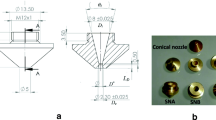Abstract
The operating pressure of gas-assisted laser cutting and the resulting exit jet pattern is one of the most important process parameters in high-pressure laser cutting. Many studies have been done to illustrate the effect of this parameter on both laser cutting quality and laser cutting capability. However, most of these studies have been done using conical nozzles. In this paper, the exit jet from supersonic nozzle has been studied, analyzed, and simulated under three different operating conditions, namely desired design, under-expansion, and over-expansion to illustrate the effect of these operating conditions on the dynamic characteristics of the exit jet. Quasi 1-D gas dynamics theory has been used to calculate the desired design operating condition, and then an axisymmetric 2-D model has been created using the OpenFOAMⓇ Computational Fluid Dynamics (CFD) toolbox to simulate the gas-assisted laser cutting flow through the modeled supersonic nozzle. Finally, the proposed simulations have been validated by comparing the results with experimental observations reported in previous literature. The effect of the turbulent viscosity has been considered through the proposed model to better simulate real conditions. Moreover, the model has been optimized to be effectively used for engineering purposes. The simulation results are qualitatively consistent with the reported experimental measurements and they demonstrate that in the case of supersonic nozzles, the exit jet pattern is characterized by high uniformity, absence of Mach disks, and bounded shape for a long distance especially under the desired design operating conditions.
Similar content being viewed by others
References
Steen WM, Mazumder J (2010) Laser material processing, 4th edn. Springer, London
Dowden J (2008) The theory of laser materials processing. Springer
Anderson JD, Anderson JD (2011) Fundamentals of aerodynamics. Anderson series, 5th edn. McGraw-Hill , New York
Cantwell BJ (2007) Fundamentals of compressible flow, 3rd edn. Stanford University
Guo S, Hu J, Lei L, Yao Z (2009) Numerical analysis of supersonic gas-dynamic characteristic in laser cutting. Opt Lasers Eng 47(1):103–110
Man HC, Duan J, Yue TM (1999) Analysis of the dynamic characteristics of gas flow inside a laser cut kerf under high cut-assist gas pressure. J Phys D Appl Phys 32(13):1469–1477
Man HC, Duan J, Yue TM (1998) Dynamic characteristics of gas jets from subsonic and supersonic nozzles for high pressure gas laser cutting. Opt Laser Technol 30(8):497–509
Hu J, Zhang Z, Luo J, Sheng X (2011) Simulation and experiment on standoff distance affecting gas flow in laser cutting. Appl Math Model 35(2):895–902
Mai C-C, Lin J (2002) Flow structures around an inclined substrate subjected to a supersonic impinging jet in laser cutting. Opt Laser Technol 34(6):479–486
Hu SX, Jingwen JL, Zhzng Z (2011) Simulation and experiment on standoff distance affecting gas flow in laser cutting. Appl Math Model 35(2):895–902
Lin J, Mai C-C (2002) Flow structures around an inclined substrate subjected to a supersonic impinging jet in laser cutting. Opt Laser Technol 34(6):479–486
Chen K, Yao L, Modi V (2001) Gas dynamic effects on laser cut quality. J Manuf Process 3(1):38–49
Hu J, Guo S, Lei L, Yao Z (2008) Characteristic analysis of supersonic impinging jet in laser machining. Int J Adv Manuf Technol 39(7-8):716–724
Zhou Y, Kong J, Zhang J (2017) Study on the role of supersonic nozzle in fiber laser cutting of stainless steel. Mater Sci Appl 08(01):85–93
Sundar M, Nath AK, Bandyopadhyay DK, Chaudhuri SP, Dey PK, Misra D (2009) Effect of process parameters on the cutting quality in lasox cutting of mild steel. Int J Adv Manuf Technol 40(9-10):865–874
Man HC, Duan J, Yue TM (1997) Design and characteristic analysis of supersonic nozzles for high gas pressure laser cutting. J Mater Process Technol 63(1-3):217–222
Wang C-C, Tseng C-S, Chen C-M (2013) A visual observation of the air flow pattern for the high speed nozzle applicable to high power laser cutting and welding. Int Commun Heat Mass Transfer 49:49–54
Wen P, Zhang C, Yuan Y, Fan X (2016) Evaluation and optimal design of supersonic nozzle for laser-assisted oxygen cutting of thick steel sections. Int J Adv Manuf Technol 86(5-8):1243– 1251
Marimuthu S, Nath AK, Dey PK, Misra D, Bandyopadhyay DK, Chaudhuri SP (2017) Design and evaluation of high-pressure nozzle assembly for laser cutting of thick carbon steel. Int J Adv Manuf Technol 92 (1-4):15–24
Greenshields C (2017) OpenFOAM User Guide
Greenshields C (2015) OpenFOAM Programmers Guide
AMES Staff (1953) NACA report (1135) Equations, Tables and Charts for Compressible flow. Technical Report 1135. National Advisory Committee for Aeronautics
Pope S (2013) Turbulent flows, 10th edn. Cambridge University Press
Asproulias I (2014) RANS modelling for compressible turbulent flows involving shock wave boundary layer interactions. Master’s thesis, University of Manchester
Yu N, Jourdain R, Gourma M, Shore P (2016) Analysis of De-Laval nozzle designs employed for plasma figuring of surfaces. Int J Adv Manuf Technol 87(1–4):735–745
Author information
Authors and Affiliations
Corresponding author
Additional information
Publisher’s note
Springer Nature remains neutral with regard to jurisdictional claims in published maps and institutional affiliations.
Rights and permissions
About this article
Cite this article
Darwish, M., Orazi, L. & Angeli, D. Simulation and analysis of the jet flow patterns from supersonic nozzles of laser cutting using OpenFOAM. Int J Adv Manuf Technol 102, 3229–3242 (2019). https://doi.org/10.1007/s00170-019-03346-5
Received:
Accepted:
Published:
Issue Date:
DOI: https://doi.org/10.1007/s00170-019-03346-5




